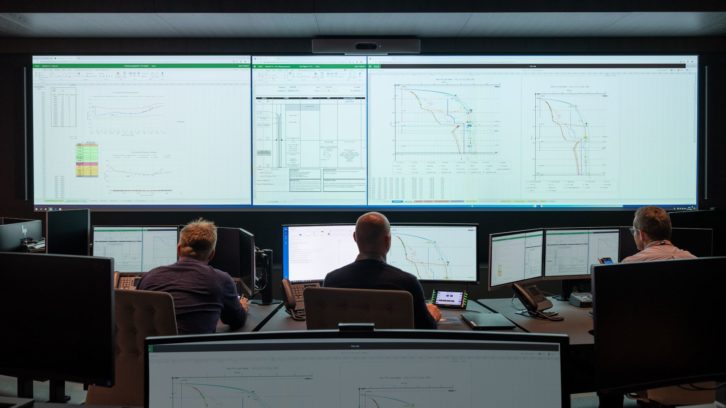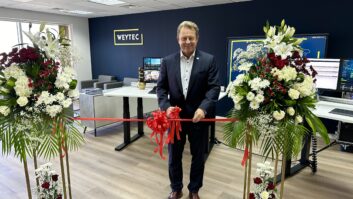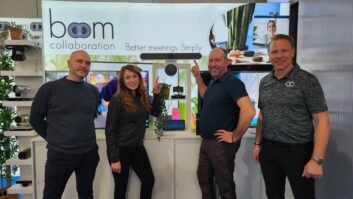
After 10 years of service, Aker BP’s Onshore Operation Center (OOC) had become too limited in capacity, and an upgraded space was needed to handle more rig lines and improve collaboration. Aker BP’s ambition was to build a new world-leading Onshore Collaboration Center (OCC) in Stavanger for its Drilling & Wells operations, designed to support ever-changing workflows and the digitalization of processes.
BP was looking for a solution that would allow their strategic alliance partners to work directly within the OCC, bringing their own systems and integrating easily with the OCC system. Where the OOC was application-specific and more rigid, the need for a new flexible solution that could easily adapt to the situations became apparent. In line with their dynamic and agile culture, Aker BP started analysing their own workflows and how the new centre should support their operations. They interviewed their operators who raised a requirement to separate the rig lines, and a need to gather the teams in the same space. They found that they needed more advanced collaboration rooms where the information could flow between the OCC and the rooms. An OCC is defined by its business-critical importance. It must ensure that ongoing offshore operations can be supported in the best possible manner combining effectiveness of onshore duties whilst ensuring that Health, Safety and Environment (HSE) are never compromised.
With the new OCC, Aker BP expands its current OOC more than 10 times with space spreading over 900sqm. A suite of interconnected rooms is designed to offer flexibility and continuity in the OCC workflows. The layout and inter-connectivity are designed to offer a premium user experience and qualitative working conditions to operators. The state-of-the-art OCC offers optimal functionality, capabilities and room layout. The floor and desk layouts are co-developed with operators to consider existing work scenarios and best practices of an OCC. Each operator will have multiple displays and one large seamless display based on blended projection technology will provide an overview of the current situation on the oil rigs.
The OCC is designed to support three main functional themes, effectively bridging the gap between people in the office, people working remotely and the people working different shifts. This environment had to be flexible enough to support these different roles, but also had to be standardized when it comes to communication protocols to and from the rig, security and high availability networks, and Aker BP network bridging. It must be compatible with the IT systems,
authentication and access methods, and it must be easy to use for the drillers, students, millennials, and to employees of all generations.
The four collaborations rooms are multipurpose in their design and can adapt quickly to different user scenarios, such as traditional meetings, video conferences, multidisciplinary workshops, trainings or breakout rooms. They are also equipped with large seamless displays that provide a large canvas to share and interact with different applications and content sources.
The lobby is designed to act as a waiting room for guests and break area for operators working 24/7. The space boasts a large central display wall giving an overview of OCC KPI’s, and various feeds from other locations. A set of dedicated screens are also used to show selected information from ongoing operations. This makes the lobby area a dynamic and engaging space, where visitors and employees are exposed to the operations and activity.
The atrium is a modern space for town-hall meetings, breaks and entertainment and ad-hoc sessions for larger groups. The space is equipped with a large display with connectivity for multiple devices and integrated with video conferencing. Two support areas were also added and built for management, coordinators, and technical support personnel. Each of these areas are equipped with sophisticated capabilities that allow users to easily connect laptops or connect desktop monitors to rack mounted workstations. The displays on the wall can be used to either show computer content directly located in one of the support areas or content coming from computers used in other OCC rooms.
The Cyviz solution consist of 13 systems, all interconnected with a new generation IP-based infrastructure for routing and data distribution. The uniqueness of the solution resides in the flexibility of this new architecture, but also in the standardisation principles applied to the design, and deployment of the solution. The flexibility is also reflected in the display technology favoured. Seamless projection with video processing, allowing multiple dynamic PiPs (Picture-in-Picture) to be added, moved and shared across rooms. The system design also had to support the two levels of access to wells’ information, with unrestricted access and tight wells, which implies severe access restrictions.
Superior video and audio quality means travelling to customer sites or between offices is much reduced, saving time and money as well as reducing Aker BP’s carbon footprint. A new IP infrastructure was developed by Cyviz, preferred to a traditional AV matrix approach that would have been too specialised and too rigid. The solution needed to be innovative and based on IT principles with a simple distribution over IP. Changing the signalling distribution and avoiding the rigidity of cabling and matrix, resulted in an ‘information highway’, allowing Aker BP to handle and distribute all data and information, making it possible to work on digital assets with much more flexibility.







